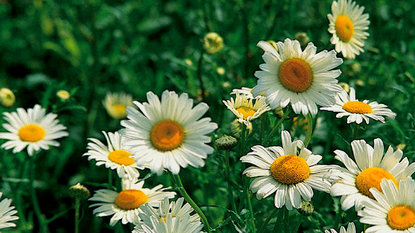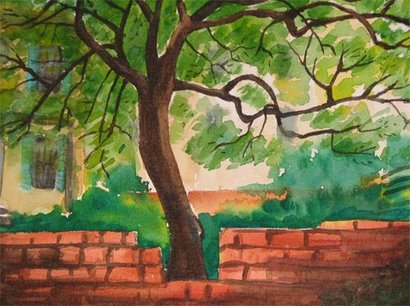
tel: 512 280-1192 thursday, august 13, 2015
Nursery Notes: the buy-one-get-one-free summer madness sale
continues. Prides of Barbados, Mexican Bush Sage and Sweet
Basil all 4.5" rounds for $3.59. Shasta Daisies, Indigo Spires
Salvia and Candlestick Plant all in 1 gal. pots for $7.99.

Shasta Daisies (part of our buy-one-get-one-free offer) are hardy
perennials. They prefer full sun to partial shade in fertile soil, and
once established, can form dense colonies. (1 gal. $7.99)
____________________________________________________
Basil Butter is easy to make, and the folks at Fine Cooking suggest
home cooks have it on hand to add flavor to pasta dishes, mashed
pototoes, grilled meats. . . or just to smear on some fresh bread.
1/2 cup of basil (which many of us have right now!), garlic, lemon
____________________________________________________
How to Build a 3-Bin Composter: all you need for this is seven
pallets (4' x 3'4"), a hammer, and a pound of 16d nails. A blueprint
and details by Anita B. Stone appeared in the most recent 'Modern
Farmer': composter New raw compost materials go into the left
bin - and move these next door after it's full. Learn how this all
works at the Homesteading Hippy.
____________________________________________________
Central Texas Gardener: a garden that mingles structural succu-
lents with perennial flowers. See how a family dumped lawn for
food and fun. Sat., 4 p.m. & Sun. at 9 a.m. KLRU
lents with perennial flowers. See how a family dumped lawn for
food and fun. Sat., 4 p.m. & Sun. at 9 a.m. KLRU

Neem: Miracle Tree for Texas?
by Mick Vann
Back in the early to mid 70’s, when I was an avid vegetable gar-
dener-chef, I heard about a tree called the Neem tree, which sounded
ike a miracle plant to me. A little background research was reveal-
ing: it was native to India and Pakistan, was very drought resistant,
and useful in myriad ways.
Its root system was great for anchoring loose soils (the UN had a
program in the Sahara using neem trees to reclaim desert sands),
the leaves increased soil fertility, while the seed cake was great as
a cattle and poultry feed.
The twigs are used by millions as a natural toothbrush, and because
of high oil content, the fast-growing wood resists termites and rot,
and is used for all kinds of construction, including houses, fence
posts, boats, piers, docks, etc. Book repositories made of neem
wood preserve paper for millennia.
The oil makes an effective industrial lubricant and lamp oil. Bitter
tender leaf shoots are eaten all over SE Asia and the Subcontinent
(excellent in Thailand with chilled raw oysters and green chile
sauce, or with fried fish and sweet sauce).
We all know about its effectiveness as an insecticide, working
We all know about its effectiveness as an insecticide, working
systemically as well as on a contact basis. It’s one of the few prod-
ucts that discourages feeding on a crop (many pesticides have to
be consumed before they are effective). It works as an enstar inhib-
itor, and as a digestive tract blocker, and has been tested as effi-
cacious on over 200 different insects. (Most nurseries stock neem
oil for use in the garden.)
Due to its antifungal, antibacterial, and antiviral properties neem
Due to its antifungal, antibacterial, and antiviral properties neem
oil has been used in Ayurvedic holistic medicine for thousands of
years. (Ayurvedic medicine is a system of traditional alternative
medicine used in the Indian subcontinent.)
Neem kills internal parasites in humans and animals, and is a very
effective spermicide. It’s also used for the treatment of ulcers, burns,
leprosy, and skin lesions, and for internal ulcers and digestive prob-
lems in the stomach.
It is used to beautify hair, skin, and nails. Villages planted them to
reduce mosquitoes and ants in the area. The list is almost endless,
so much so that it is called “the village pharmacy” in India and
“the miracle tree” in Muslim countries, and it does all of this while
being completely non-toxic to humans.
New research indicates it is effective as an immune-booster, a liver-
protector, a possible diabetes treatment, and a rich source of anti-
oxidants when used as a dietary supplement. It is being tested in
anti-aging compounds and treatments for dry, itchy skin. Western
researchers are just starting to scratch the surface to discover what
the Subcontinent has known for thousands of years.
Jim Hightower, the Texas Agriculture Commissioner before Rick
Jim Hightower, the Texas Agriculture Commissioner before Rick
Perry succeeded him and took credit for all of Jim’s progressive
programs, was a regular at the restaurant where I was a chef. I
talked neem up to Jim when he came in, and Jim got me some
seeds from the USDA Research Station down in Florida, where
they were conducting trials.
My theory was that if Chinaberry (Melia azaderach) was a first
cousin of Neem (Azidirachta indica), and Chinaberry grows like
a weed here, there were two things to consider.
1. Does Chinaberry contain enough azadirachtin in its seeds to be
useful? (dunno; I’ve never been able to get any eggheads interested
in finding out) or, 2. Would Neem prosper down in the Valley,
ensuring a local Texas source for oil extraction? (turns out that it
doesn’t appreciate temperatures much below 36°F).
The neem tree is nothing short of a miracle plant, providing so
The neem tree is nothing short of a miracle plant, providing so
many benefits they are almost too numerous to list (and I’ve only
scratched the surface in extolling its virtues). I would so love to
be able to grow neem trees here, but I think it gets too cold in the
winter. Still, if you were really dedicated, you could probably pull
it off. And maybe after we globally-warm a little more, the neem
will become an adapted plant. Texas’s new miracle tree!
____________________________________________________
Mick Vann is a horticulturist, food writer and blogger, chef, rest-
aurant consultant. Read Mick’s blog at gustidude


Please contact newsletter editor Darrel Mayers (pictured above)
with any ideas for articles or interesting links:
internationalrain@yahoo.com
(hitting 'reply' to this email won't work)Visit the website: Its About Thyme facebook
Visit the nursery:11726 Manchaca Road, Austin, 78748